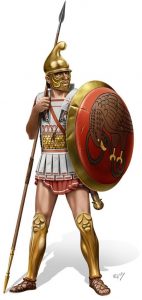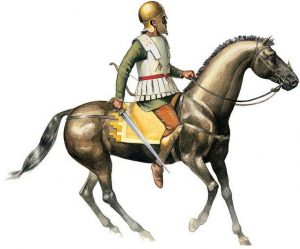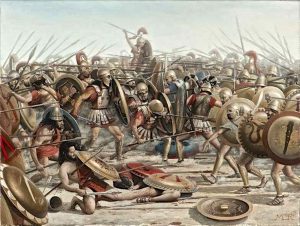Ancient Greece was divided into different policies. It was more like how the United States of America is today. The city-states (poleis) were the building blocks of Greece. Each city-state had its own government, its own rules and public systems and Ancient Greek military.
They were all different but had a common Greek background. These city-states would often indulge in wars with each other or sometimes become allies of one another to fight some opponents. Hence, all the city-states had to have strong military forces and were always forced to be war ready.

Earlier, in the archaic period, no Greek city-state had a professional army. Training wasn’t organized and weapons were also of low quality. Sparta, the warrior city-state of Ancient Greece, came out with a regular army of well-trained soldiers. Spartans had a professionally trained army force which was on job for full-time.
Prior to this, most Greek city-states would have normal citizens serve in the army during wars post which they would return to their original occupation of farming. After Sparta deployed a full-fledged army, many Greek city-states like Athens, Argos, Syracuse, Thebes etc. followed suit.
Most city-states had small to medium sized Ancient Greek Military forces which were also paid for their services. These forces were increased in size in times of war with the normal citizens serving the army as and when necessary. The professional force was called log ads and the forces which compiled of citizens was called hoplites. Most Greek city-states had similar armor.
Nature and Composition of Ancient Greek armies
The ancient Greek states other than Sparta did not have a standing army and the soldiers were mostly farmers. Warfare was seasonal in character as no one wanted to be away from their lands during the harvest season.
The power of a state depended on its capacity to mobilize soldiers to fight. They brought their own equipment as they did not receive any salary and thought of it as an honor and duty to fight for their state.
The Ancient Greeks believed in quick decisive warfare without any unnecessary stretching of wars. They started by invading enemy lands and burning their crops. The enemy soldiers had a choice between fighting and choosing to starve.
They mostly came out with their own hoplites to defend their lands and met on plain lands with open war against the enemies.
It took only a matter of time as a break in the lines resulted in a rout. It was mostly done with the intention to gather tribute and not complete subjugation.
Ancient Greek Military Weapons
Although the Greeks states fought almost similarly with similar tactics, there were also certain minor regional variations which sometimes led to different types of troops.
The most common type of weapons used by these troops was quite identical and was:
- The long spear: The six to ten feet long spear or Doru was used by the soldiers as their main offensive weapon which was held on the right hand in an underhand position while approaching the enemy and in an overhand position to attack in close quarters.
- A stabbing sword: Along with the spear they used a short iron sword known as Xipos, when the spear broke or they had broken through the opposing lines
-
The double-handed shield: The main feature of the ancient Greek military was their double-handed shield known as the Aspis. It was their primary defensive weapon which they used to cover themselves as well as their fellow soldier to their left. It was also used to push their opponents after the immediate shock collision with the opposing soldiers.
- Missile weapons: Some states used some lightly armed mobile troops alongside their heavy infantry to disrupt the enemies. They used javelins, and even rocks at the enemies to put a hole in their lines and weaken the enemy before the ultimate clash.
Ancient Greek Armor
The hoplite army consisted of heavy infantrymen. Their armour, also called panoply, was sometimes made of full bronze for those who could afford it, weighing nearly 32 kilograms (70 lb), although linen armour was more common since it was less costly and also provided adequate protection. It included the Corinthian Helmet and the Bronze breastplates. The helmet was heavy but provided decent protection and also seriously impaired vison making them almost impossible to act alone. So the hoplites used extreme body armaments for protection and shows the phalanx was mainly a defensive formation.

Ancient Greece military training
There is very little evidence of training in Ancient Greek armies. As most armies consisted of farmers and wealthy citizens who fought seasonally there was little scope for training as it was not a standing army.
The only state to have an army resembling a modern standing army was Sparta. As most agricultural work was done by the helots, the free male citizens were all trained to be soldiers.
They practiced a very rigorous form of training and prided themselves as the best army.
It was only during the reign of Philip II of Macedon, who started keeping a standing army with professionally trained soldiers.
Ancient Greek Military Tactics
With time the Ancient Greece Military forces in Ancient Greece became much more structured. They would have hierarchies much like what we have today. They would use different formations and tactics in wars. One of the most prominent formations of the hoplites was the phalanx.
Mycenean age tactics
Hoplite warfare tactics
But with the coming of the archaic period, the Greek city-states started adopting the Hoplite warfare in Phalanx formation.
The exact dates of its origin are uncertain but are generally taken to be around mid-7th century BC and many have attributed its beginning to Sparta.
The Hoplites were heavy infantrymen wearing heavy armor and heavy Corinthian helmets providing great protection. It was generally a defensive type of warfare where they formed a uniform rectangular block of hoplite with each other in a compact line and supported by lines behind them. They generally met in an open field and finished in a swift decisive battle as sieges and tactics were considered cowardly by the Greeks in that period.
Both sides would charge each other in formation and engage in a shock collision and the side first breaking was one who was defeated as this tactic deepened on its compactness. The lines were closely placed and engaged in pushing battles sometimes. They also used their spears to attack their enemy. Once the enemy broke there was no hope and most fled or were killed.
The Peloponnesian war tactics
The Peloponnesian war began with hoplite battles but it was quite a defensive war with the Athenian Military rarely facing the enemies on land. They planned to disrupt Spartan supply lines and engage their allies’ navally.
This war presented a different way of warfare mostly devised by the Athenians. After the Persian Battles, they had understood the importance of navies. They had built a powerful navy that could engage enemies through ports and also bring in food and tribute to sustain the siege by Sparta. Instead of engaging the enemies directly, they poured their hoplite wherever necessary and more effectively in spite of having lesser land troops.
The war was ultimately won by Sparta due to firstly an Athenian debacle in the Sicily campaign and also due to the building of a powerful navy themselves which won them the war. In this period, Hoplites were still important but not the only troops fighting and naval strength became more effective.
The Macedonian tactics
The Macedonians were always known as fierce warriors and it was Philip II who made them a force to reckon with as they brought most of the Greek states under their control. They mixed scientific methods into their army with professional engineers used for breaking sieges and also kept a professional standing army.

As ancient Greece was surrounded by sea, it was inevitable to have naval forces. City-states like Athens, Rhodes, and Corinth etc. had warships. These were large ships, light in weight and could carry as many as 200 soldiers.
The Athenians had the largest navy which allowed it to build a Mediterranean-wide empire.Hence, the ancient Greeks started with a very informal kind of a military but the Spartans led the way in the formation of more formal military forces and from then on there was no looking back for any Greek city-state.
Ancient Greek Military achievements
The biggest achievement of the Greek military can be said to be the repulsion of the Persians. The Persian Achaemenid Empire at that time was an extremely wealthy empire with a huge army. They continuously invaded the Greek lands and it lasted for about 50 years.
With armies much smaller in size than the Persians, the Greek phalanx proved much superior with Persian archers failing to penetrate hoplite armor. They used the environment to their advantage and defeated them in the battle of Marathon which has found a place in the memory of people even today through popular culture. The battle of Thermopylae was another legendary battle where the 300 Spartans held the Persians with a huge army at a narrow pass for several days and it inspired the Greeks to throw the Persians out of the Greek lands.
The army of Alexander was another legendary army that conquered an empire bigger than any empire history has ever seen. It conquered from the Greek lands to the North African areas up to the northwest part of Indian subcontinent leaving the world in terror of the ferocious army.